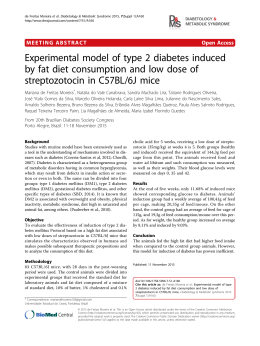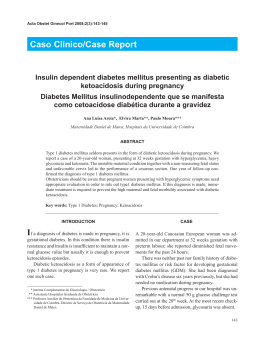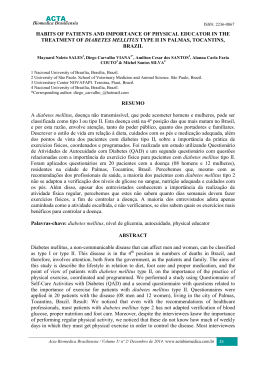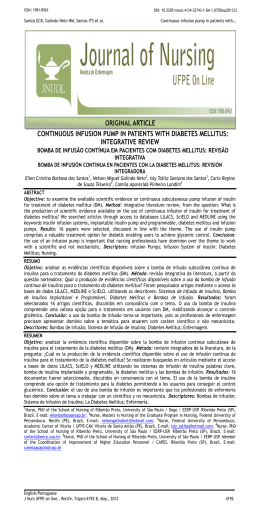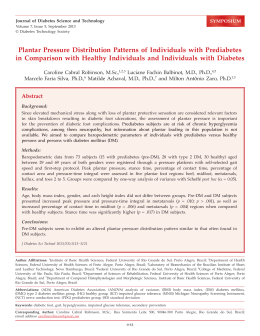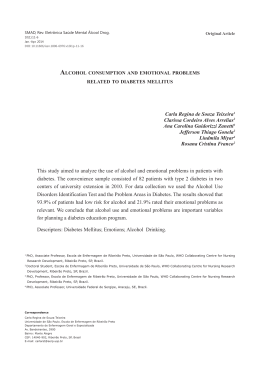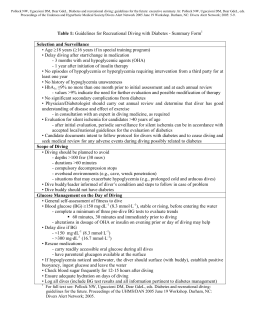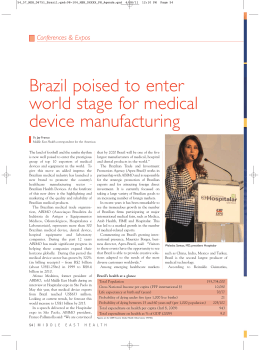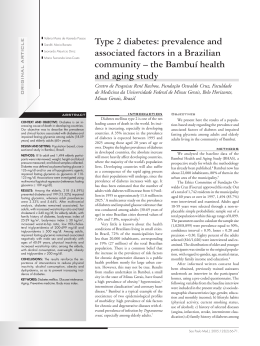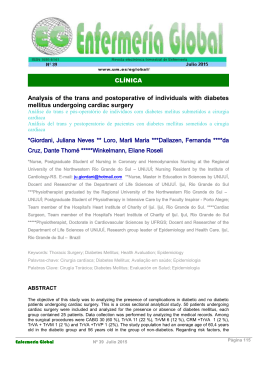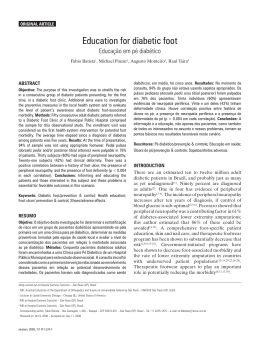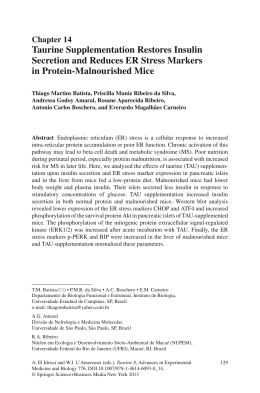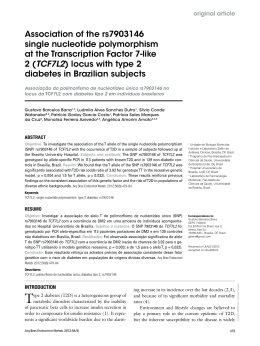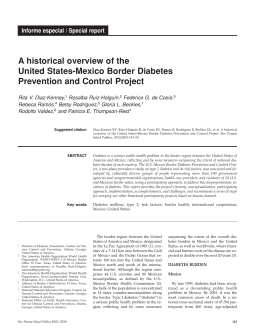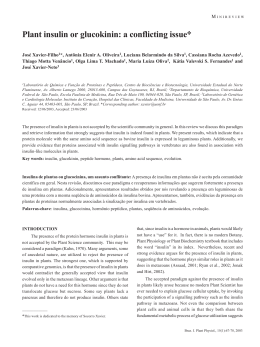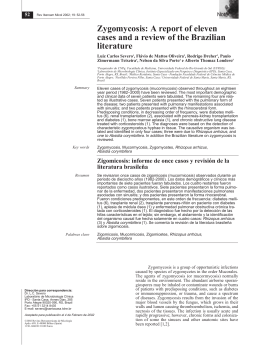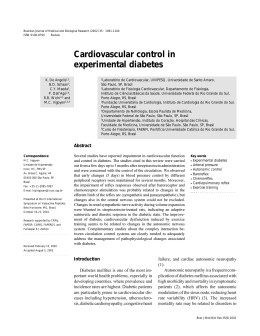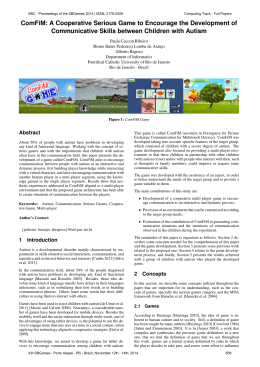A Game for Training Medical Doctors on Insulin Use for Diabetic Patients Leandro A. Diehl, Rodrigo M. Souza*, Juliano B. Alves*, Roberto Z. Esteves#, Pedro A. Gordan, Maria Lúcia S. G. Jorge§ State University of Londrina, Brazil; *Oniria Software Industry, Brazil; #State University of Maringá, Brazil; §Pequeno Príncipe Colleges, Brazil Abstract Starting or adjusting insulin is one of the major difficulties of primary care physicians who treat patients with diabetes mellitus (DM). We describe in this paper the development of a serious game for education of medical doctors and students on insulin prescribing for DM, using principles from adult and professional education. Characteristics of our game include: a well-defined curriculum of contents; use of simulated clinical scenarios similar to those observed in a primary care setting and with increasing complexity; hands-on approach; constant feedback, derived from updated and highquality recommendations from literature; and incorporation of game elements to make the learning experience more enjoyable and appealing. A "case editor" has been included to allow clinicians to edit the game levels without help from programmers. The game can be published on the Web, which makes it very interesting for large-scale continued medical education. Keywords: Insulin, Diabetes Mellitus, Serious Game, Medical Education, Games for Change. Authors’ contact: Leandro A. Diehl - [email protected] 1. Introduction Diabetes mellitus (DM) is a major public health problem [Wild et al. 2004]. Most DM patients are treated by generalists in a primary care setting, in Brazil; from these patients, only 6-11% have good control of their disease [Assunção 2001]. One of the greatest difficulties faced by primary care physicians, regarding DM treatment, is insulin initiation and adjustment [Hayes 2008]. Probably, the best way to revert this scenario would be continued medical education on diabetes [Peyrot 2010; IDF 2008]. However, traditional educational activities have low efficacy [Renders 2011] and its benefits tend to fade with time [Sharp 2002]. In the other hand, the use of computer games and simulators is a new and very promising approach for medical education [Issenberg et al. 2005; Akl et al. 2010]. Serious games can be designed to address virtually any educational demand, and its application to medical education is coherent with the principles of adult and professional learning [Aldrich 2009]. Current trends in medical education also support problem-based learning and the use of simulated patients, improving real patients´ safety and stimulating the active search of information by students [Barrows 2000; Issenberg et al. 2005]. There is a number of games available for education of diabetic patients [Lehmann 1997], but, to our knowledge, there are no published data on the use of games for professional education on DM. 2. Related Work Serious games are being used for education of patients with diabetes mellitus (specially type 1 diabetic children) in the last 15 or 20 years. A few examples are the games developed by Raya Systems Inc. (California, USA), which intend to teach children of scholar age about the main aspects of diabetes selfmanagement using entertainment: "BG Pilot" and "Captain Novocare" for PC, and "Captain Novolin" and "Packy & Marlon" for Super Nintendo TM [Lehmann 1997]. Their use by this population is associated with better educational and health outcomes; for instance, children who played 'Packy & Marlon' developed better self-care behavior and reduced need for urgent doctor visits [Brown 1997]. For professional education, there are a few computerized simulations, but no games. An interesting example is AIDA, a Web-based freely available interactive simulator (http://www.2aida.net). AIDA creates graphics to simulate blood glucose levels and insulin action during a 24-hour period from a mathematical model [Lehmann and Deutsch 1992]. In the AIDA website, the user can interact with a number of hypothetical patients with DM, making adjustments in carbohydrate intake and in the timing and dosages of 3 different types of insulin. The simulator then presents the effects of these adjustments on the patient´s glucose and insulin levels. The tool has demonstrated to be useful for education of primary care physicians about insulin management in diabetes [Tatti and Lehmann 2001]. Other example is the Insulin Simulation Instruction System (ISIS), also available on the Web (http://www.simation.us/pro/isis/). ISIS presents some clinical vignettes and asks the participants for making choices regarding insulin initiation and adjustment, providing feedback to the player after resolution of each case. Physicians who used ISIS have found it relevant, realistic and engaging [Miller 2011]. Despite their good educational background, both simulators have limitations: their graphic presentation is old-fashioned and excessively based on texts and charts, and the possibilities of interaction are limited. So, they are little attractive and become repetitive and boring for the user after a little time. We believe that the inclusion of game elements and varied ways of interaction can make the learning experience more enjoyable, attractive, and, possibly, more educationally effective. So, we decided to develop a serious game, combining both the educational qualities of already existing diabetes simulators and also game elements, in order to create a new tool for education of health professionals on the main aspects of insulin management in DM treatment, which could be more fun, engaging and attractive that the previous applications - and, this way, stimulating its spontaneous use by the target population, composed by busy health professionals with little or no time availability to join traditional educational activities. This paper describes the development of a serious game prototype for education of medical doctors and students on insulin management for treatment of DM in a primary care setting. 3. Methods 3.1 Initiation We defined generalist clinicians working in primary health care as our target audience. Two clinical endocrinologists (LAD, RZE) with large experience in DM treatment and medical education defined the main topics on insulin management which should be addressed in this game, based on previous surveys on the major doubts and difficulties of primary care physicians on this matter [Funari et al. 2002; Hayes 2008]. This minimum curriculum of contents was used to design a series of hypothetical clinical vignettes (cases) of diabetic patients in need of insulin initiation or adjustment. The cases were carefully written to represent clinical situations commonly found in the context of treating insulin-requiring diabetic patients in a primary care setting. Each case was designed to fulfill at least one of the topics from the minimum curriculum, and each topic is addressed in at least one case. These cases were further used to create the game levels. next level. Adventure genre characteristics are aligned to basic principles of adult education (active experimentation, contextualized learning, reinforcement of the value of previous knowledge, individualized timing and rhythm of learning), which make this game genre very attractive for use in professional and adult education [Aldrich 2009; Rollings and Adams 2003]. The game is composed by a central narrative, from which the player, who assumes the role of a medical doctor, is presented to a predetermined, increasingcomplexity sequence of hypothetical patients (the cases, or levels). In each case, the player is then required to make decisions regarding the best choices to improve the control of that patient, based on his clinical judgment and his previous knowledge. After each decision, the game provides immediate feedback, showing the patient´s outcome and comparing the player´s choices with the best recommendations from medical literature. Suggestions and links to additional learning resources (texts, guidelines, algorithms) are also offered. Only the correct choices take the player to the next level and give him rewards (points, bonuses). The game also should include entertainment resources and activities, in a way that it can be scientifically accurate and pedagogically adequate, but also fun to play. 3.3 Execution A first interactive prototype was developed, using Action Script 3.0 for the Flash Player platform, with a simple graphic interface (grayscale, 2D), in order to test the game´s interaction dynamics. Several types of interaction were tested, from which the team selected the best to be kept in the game. We intended to include in the game varied possibilities of interaction, in order to make the gaming experience well balanced and enjoyable. Each level (case), in general, includes most of the following types of interaction: a) inventory - organizes all the other activities, which are disposed as items from a menu, and are consecutively shown as the player successfully completes the activities of the level (Figure 1); 3.2 Planning Our development team was composed by endocrinologists (LAD, RZE), experts in medical education (PAG, MLSGJ) and game designers (RMS, JBA). Several team meetings were undertaken in order to define the best specifications for the game. The task to choose the best gameplay was to define the priority between three aspects of game design: narrative, interaction and strategy. The specifications of the game turn the decision to narrative type, where the challenge is to understand a plot and make decisions based on that. So the game should not require much skill to play or a complex rule. We choose to develop an Adventure-genre game, in which the player needs to explore and correctly solve consecutive puzzles and problems to proceed to the Figure 1: Screen of the game, showing the virtual patient and the options of interactions available to the player b) dialogue - the player "talks" with the patient, by selecting among a list of possible sentences or questions to ask; c) physical exam - the player gets information on findings from patient´s physical exam by clicking in body parts from the patient´s figure; d) content screens - present additional information, as results of lab tests, blood glucose assessments brought by the patient, previous history from the chart; e) quiz - the player must select the correct answer for a multiple-choice question related to that patient; f) puzzle - the player must correlate pieces of information shown in the chart or lab tests to specific questions, clicking and dragging the right data to the "answer" field (Figure 2); These elements of interaction trigger the history across the player progress. The main objective of the game is to collect all the necessary information to be able to choose and perform the correct adjustment in the patient´s insulin dosage. The characters (doctor, patients) and the scenarios of the game were designed in a realistic way, attempting to reflect the phenotype of most diabetic patients and a real primary health care environment. However, we choose making the graphic interface simple, in order to further publish the game in a Web page, since the use of heavy images or high-definition videos or animations could make the game experience very slow or intermittent with slow internet connections. A user-friendly interfaced "case editor" was included in the software, to allow that the clinical participants of the team (not familiar with software programming) can easily create, delete or modify the levels of the game and the help files at their will, with no need of assistance from the programmers. 3.4 Control Figure 2: Example of a puzzle, where the player must find the correct data in patient´s talk and drag them to the correct spots in the questions shown below g) insulin adjustment - after completing his thorough clinical assessment, the player makes his decision and makes adjustments to the insulin scheme (type, dose, timing) using a sliding scale (Figure 3); The next steps in the development of the game will be the revision of the animations of the content and the usability inspection. For the usability tests, 10 medical students from Londrina State University and 10 physicians who work in the city of Londrina, from both genders, with any level of computer gaming experience, will be included. The usability test will be conducted using the Heuristic Evaluation for Playability (HEP), as described by Desurvire et al. [2004]. The players will also be asked to fill out a short questionnaire on his satisfaction with the game experience, with answers in a Likert scale. After that, final adjustments in game design and programming will be made, and the clinical participants of the team will insert the previously written clinical cases into the software, choosing the most appropriate types of interaction and its sequence for each level, as well as the help files and additional learning resources. 3. Results and Future Directions Figure 3: Sliding scales for insulin dosage adjustments. h) feedback, help files and additional learning resources - available at several points of the game, they offer to the player practical concise recommendations and hints to solve game problems. One of the challenges in educational games development is the conversion of traditional content in a game. In a traditional model of production, it would require constant interaction between game designers and experts during the development, something expensive and slow. In our game, fortunately its design and development is being possible thanks to the cooperation among experts from several areas: clinical endocrinology, medical education and game design/programming. The multidisciplinarity or our team is a source of different ideas, which only contribute to make the final product richer and better. An interesting feature of our game is the inclusion of the editor of cases. This tool was designed to be a software capable of integrating medical experts in game development more efficiently, because they should increase the game's content by yourselves, with no need of help from programmers. The final complete version of the game should be ready by December, 2011. Our plans are to evaluate its educational value, by comparison of the learning outcomes of 2 groups of medical doctors: one playing the game in his own time and rhythm, and the other going through a "traditional" activity (didactic lectures and discussion of clinical cases) with the same content. If we could be able to prove that the use of a Webbased computer game, build on a well-defined curriculum of content and adherent to the principles of adult education, can be equally efficient, to education of health professionals on the treatment of an important health condition, as the more traditional didactic approaches, or even better, then we will collaborate to expand the road to wider research, development and application of games for medical education. Also, as proposed in the movement of "Games for Change", we can use a game to help improve our world [McGonigal 2011] - in our case, by better training of health professionals on DM and consequent better treatment of diabetic patients. The possibility of publishing this game on a Web page, and the creation of a "case editor" which allows customization of the game levels by a person with no programming expertise, make it a very interesting option for large-scale continued medical education on a wide range of topics. 4. Conclusion In conclusion, we believe that a game can be a useful educational tool for education of health professionals about insulin use in DM treatment, with the additional advantage of being more fun and attractive to the target audience, without compromising its educational and scientific quality, and potentially applicable to large-scale continued medical education. However, for its optimal design and development, there is a need for assembling a multidisciplinary team which includes professionals from different fields, such as: game designers, physicians and medical educators. Acknowledgements The authors would like to thank Dr. Eldon Lehmann, who contributed with his own work and ideas to the progress of this work; and all friends who gave us their valuable ideas on the design and content of the game. References AKL, E.A., PRETORIUS, R.W., SACKETT, K., ERDLEY, W.S., BHOOPATHI, P.S., ALFARAH, Z. ET AL., 2010. The effect of educational games on medical students´ learning outcomes: a systematic review: BEME Guide No 14. Medical Teacher, 32, 16-27. ALDRICH, C., 2009. The complete guide to simulations & serious games: how the most valuable content will be created in the age beyond Gutenberg to Google. San Francisco: Pfeiffer. ASSUNÇÃO, M.C.F., SANTOS, I.S. AND GIGANTE, D.P., 2001. Diabetes mellitus at the primary health care level in Southern Brazil: structure, course of action and outcome. Rev Saúde Pública, 35, 88-95. BARROWS, H.S., 2000. Practice-based learning: problembased learning applied to medical education. Revised edition. Springfield: Southern Illinois University School of Medicine. BROWN, S.J., LIEBERMAN, D.A., GERMENY, B.A., FAN, Y.C., WILSON, D.M. AND PASTA, D.J., 1997. Video game that improves juvenile diabetes care: results of a controlled trial. Medical Informatics, 22, 77-89. DESURVIRE, H., CAPLAN, M. AND TOTH, J.A., 2004. Using heuristics to evaluate the playability of games. In: Proceedings of the ACM SIGCHI Conference on Human Factors in Computing Systems (CHI 2004), 24-29 April 2004, Vienna. Vienna: ACM. FUNARI, L.A., PERON, G., SENHORINI JR., S. AND ESTEVES, R.Z., 2002. Viewpoint of the family physician regarding diabetes mellitus. In: Proceedings of the II Congresso Paranaense de Clínica Médica, 6-8 June 2002, Curitiba. Curitiba: Sociedade Brasileira de Clínica Médica. HAYES, R.P., FITZGERALD, J.T. AND JACOBER SJ, 2008. Primary care physician beliefs about insulin initiation in patients with type 2 diabetes. Int J Clin Pract, 62, 860868. INTERNATIONAL DIABETES FEDERATION - IDF, 2008. International curriculum for diabetes health professional education. Brussels: IDF. ISSENBERG, S.B., MCGAGHIE, W.C., PETRUSA, E.R., GORDON, D.L. AND SCALESE, R.J., 2005. Features and uses of highfidelity medical simulations that lead to effective learning: a BEME systematic review. Medical Teacher, 27, 10-28. LEHMANN, E.D. AND DEUTSCH, T., 1992. A physiological model of glucose-insulin interaction in type I diabetes mellitus, Journal of Biomedical Engineering, 14, 235-42. MCGONIGAL, J., 2011. Reality is broken: why games make us better and how they can change the world. New York: Penguin Press. MILLER, D. AND ROBERTS, P., 2011. Using computer simulation as an insulin prescribing virtual preceptorship. In: Proceedings of the 71st American Diabetes Association Scientific Sessions, 24-28 June 2011, San Diego. Diabetes, 60(Suppl.1) A195-A235. PEYROT, M., RUBIN, R.R. AND KHUNTI, K., 2010. Addressing barriers to initiation of insulin in patients with type 2 diabetes. Primary Care Diabetes, 4(Suppl.1), S11-S18. RENDERS, C.M., VALK, G.D., GRIFFIN, S.J., WAGNER, E.H., EIJK, VAN J.TH.M. AND ASSENDELFT, W.J.J, 2001. Interventions to improve the management of diabetes in primary care, outpatient, and community settings. Diabetes Care, 24, 1821-1833. ROLLINGS, A. AND ADAMS, E., 2003. Andrew Rollings and Ernest Adams on game design. Indianapolis: New Riders Games. SHARP, L.K. AND LIPSKY, M.S., 2002. Continuing medical education and attitudes of health care providers toward treating diabetes. J Contin Educ Health Prof, 22, 103112. TATTI, P. AND LEHMANN, E.D., 2001. Utility of the AIDA diabetes simulator as an interactive educational teaching tool for general practitioners (primary care physicians). Diabetes Technology & Therapeutics, 3, 133-40. WILD, S., ROGLIC, G., GREEN, A., SICREE, R. AND KING, H., 2004. Global prevalence of diabetes - estimates for the year 2000 and projections for 2030. Diabetes Care, 27, 1047-1053.
Download
